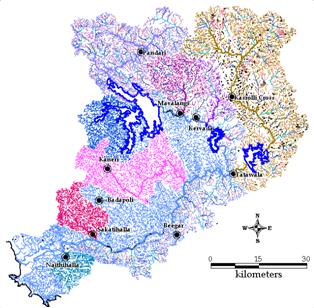 |
ENVIS Technical Report: 29
October 2008
Ecological Status of Kali River Flood Plain |
 |
4.0 Methods
To assess the ecological importance of the region, a study was undertaken covering vegetation, aquatic ecosystems, amphibians and birds:
Vegetation : Random opportunistic survey covering different habitats were visited including mangroves. The plants collected were identified according the Hooker’s system of classification. Rare plants were photographed and/or pressed for herbarium collection. The location of the area was recorded using a Global Positioning System (GPS).
Aquatic Ecosystem : A standard method was used for water sampling. Water samples were collected in polyethylene bottles 0.5m below the surface at ten sample sites along the river stream (Figure 7) in all seasons (during 2007). All glass and plastic ware used for sampling and analyses were rinsed with distilled water. All lab measurements were performed within the threshold limit day of respective parameters. EXTECH combined electrode probe were used for determination pH, Water temperature, conductivity and Total dissolved solids, Thermo Orion Nitrates Ion Selective Electrode used for NO3 determinations, Secomam spectrophotometer were used for Phospahtes and Sulphates determinations, Systronics Flame Photometer was used for sodium and potassium determination. All reagents were analytical grade and it is supplied by the instrument makers or prepared as per the Americam Public Health Association Standard Methods. Standard methods (APHA, 1998) were used for determination of free carbon-di oxide, dissolved oxygen, alkalinity, chlorides, total hardness, calcium hardness, magnesium hardness on site and analysis of phosphates, sulphates, sodium, and potassium on lab.
Amphibian diversity : Systematic surveys were carried out in 10 sampling localities of the Kali river catchment in all seasons (during 2007-08). Visual encounters, calls, tadpoles, foam nests, spawn are used to record the amphibians in the field. Two man hours of searching is made using torch lights between 19:00-20:00 hr, by walking across the streams, forest floors, gleaning leaf litters, prodding bushes, wood logs, rock crevices etc. All the species encountered are identified up to species level (if not up to genus level) using the keys of Bossuyt and Dubois (2001) and Daniels (2005). Opportunistic encounters are also recorded to enlist the species of the region.
Bird diversity : Birds were observed from 8:00 am to 10:00 am in the morning and 4:00 pm to 6:00 pm in the evening. Birds seen or heard were recorded. An Olympus 10 X 50 binocular was used and Field guide for Birds of Indian Subcontinent was referred for identification of birds.

Figure 7: Sampling sites in Kali River Basin